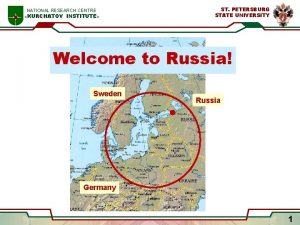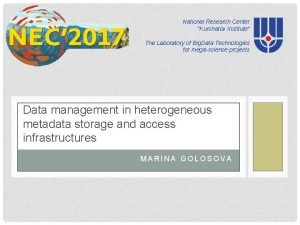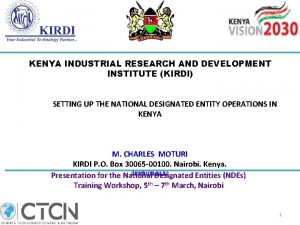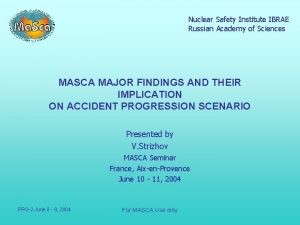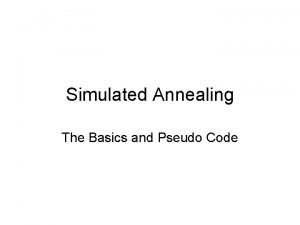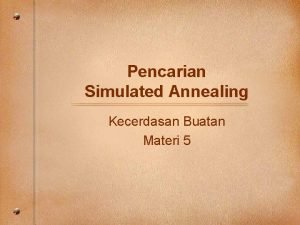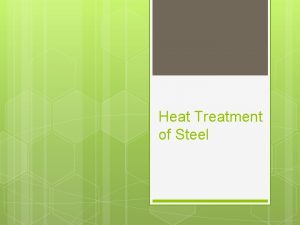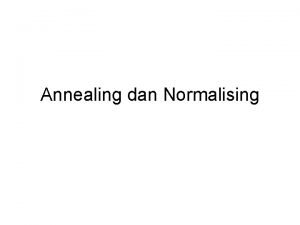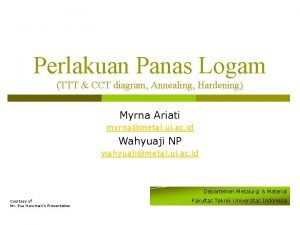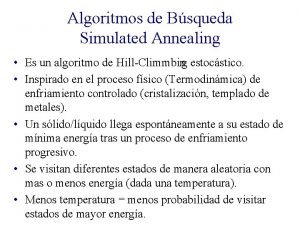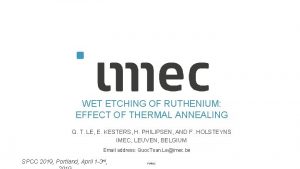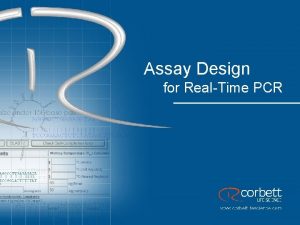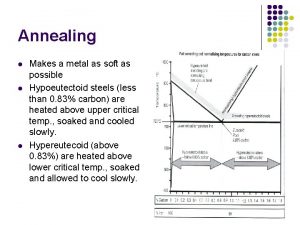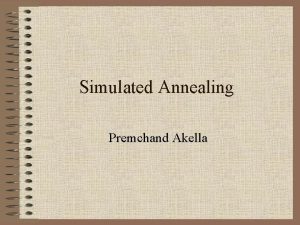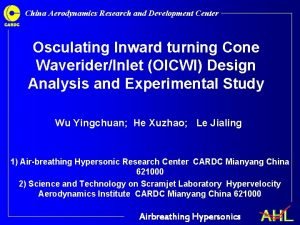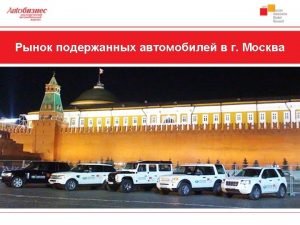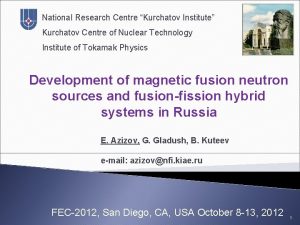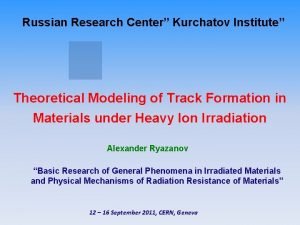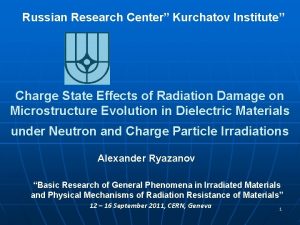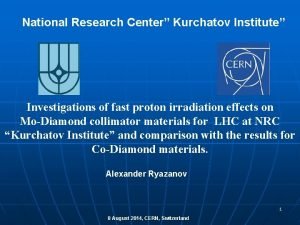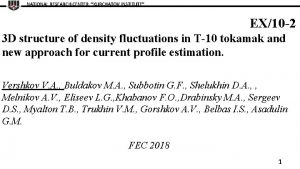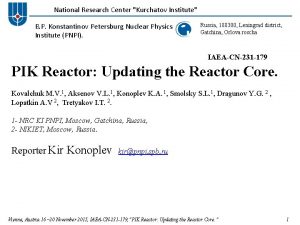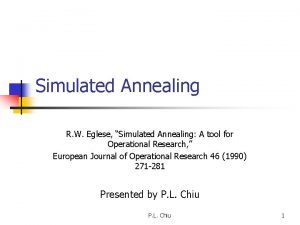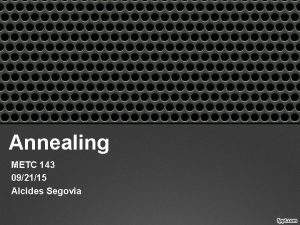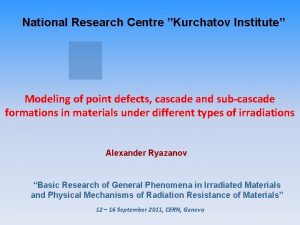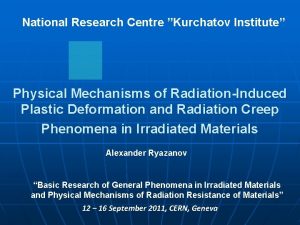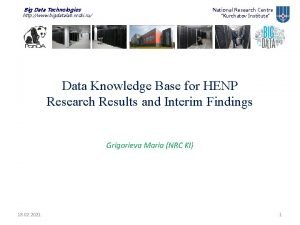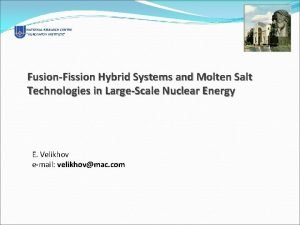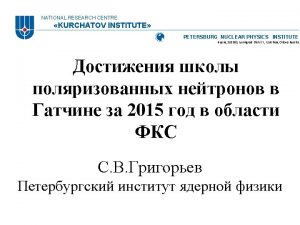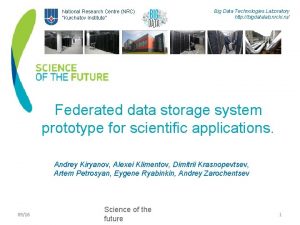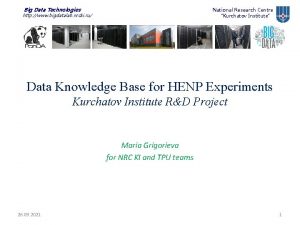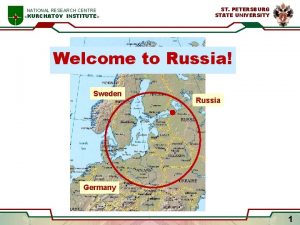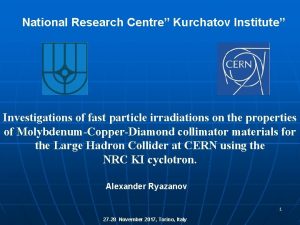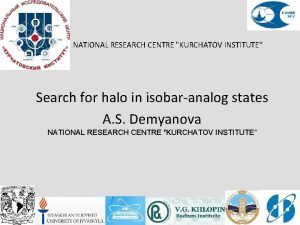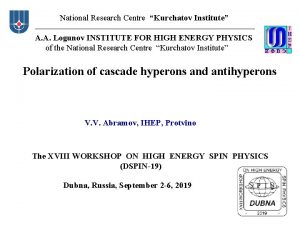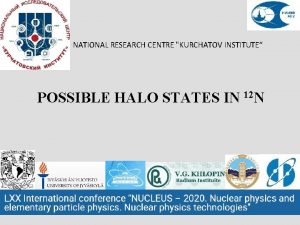RUSSIAN RESEARCH CENTER KURCHATOV INSTITUTE Development of annealing
























- Slides: 24

RUSSIAN RESEARCH CENTER KURCHATOV INSTITUTE Development of annealing for VVER-1000 reactor vessels Experimental assessment of possibility for performance of restoration anealing Ya. I. Shtrombakh

The lifetime of VVER reactor vessels mainly depends on irradiation embrittlement of weld joint materials Generation 1 VVER - 440/230 Generation 2 VVER - 440/213 VVER - 1000 Elements impacting irradiation embrittlement To 0, 22% To 0, 048% To 0, 027% < 0, 3% < 0, 08% < 0, 012% 1, 2 - 1, 9% 2

3 Performance of restoration annealing at VVER-440 reactor vessels VVER-440 Annealing efficiency Annealing temperature

Rating of VVER-440 units by chemical composition of the weld joints By Tec. Spec for weld joints of Rovno NPP-1 0. 037%Р Rovno NPP 1 0. 21%Р 4

Cutting of templates for assessment of the real conditions in VVER-440/320 reactor vessels 5 5× 5 10× 10 If Tk 5 5 0°C: Tk 10 10 = 53. 5 + 0. 94 Tk 5 5 + 2. 62 10 -4 (Tk 5 5)2 , °C If Tk 5 5 0°C: Tk 10 10 = 53. 5 + 1. 00 Tk 5 5 + 1. 37 10 -4 (Tk 5 5)2 , °C

VVER-1000 RO MKR raises significantly with increase of Ni concentration 6

7 Range of Ni concentration change in the weld joints Activities necessary for LTE 1. 70 - 1. 88 Monitoring of radiation loads for ensuring of the designed life and ANNEALING for LTE 1. 57 - 1. 64 Monitoring of radiation loads for ensuring of the designed life additional attestation for LTE 1. 10 - 1. 21 The designed life is ensured Additional attestation for LTE

Mechanisms of irradiation embrittlement caused by nano-structure evolution IRADIATION EMBRITTLEMENT Irradiation strengthening Radiation-induced precipitates Radiation defects Development of intergranular segregations of impurities Brittle intergranular destruction 8

Brittle intergranular destruction 9 Intensity, s. u. Kinetic energy, e. V The spectrum of OZ electrons from the intergranular surface of the reactor vessel destruction (F=6, 5 1023 м-2). The presence of phosphor intergranular segregations is visible

Changes of density of the radiation induced segregations in the weld joint of VVER-1000 Ф = 3, 1× 1023 н/м 2 N=70 -90× 1021 м-3 Ф = 6, 5× 1023 н/м 2 N=300 -500× 1021 м-3 Ф = 11, 6× 1023 н/м 2 N=700 -800× 1021 м-3 10

Changes of density in the dislocation loops of VVER-1000 weld joint Ф = 3, 1× 1023 н/м 2 N=5 -6× 1021 м-3 Ф = 6, 5× 1023 н/м 2 N=10 -20× 1021 м-3 Ф = 11, 6× 1023 н/м 2 N=400 -600× 1021 м-3 11

Radiation induced segregations in the weld joints of VVER-1000 made of the atoms of Ni, Mn, Si e r th ity, e h hig ens d e h s T tion a g re seg The b igger displa ceme of Т nt К M. K. Miller, A. Chernobaeva, Y. I. Shtrombakh, K. F. Russell, R. K. Nanstad, D. Y. Erak, O. O. Zabusov. , Evolution of the nanostructure of VVER-1000 RPV materials under neutron irradiation and post irradiation annealing. , JNM, 2009 12

13 Dependence of maximum temperature for temper brittleness from nickel concentration in the steel (duration 100 hrs) Temperature-time diagram of isothermal embrittlement of Cr-Ni-Mo steels Temperature Displacement of embrittlement temperature

Experimental effectiveness justification for the annealing of VVER-1000 reactor vessel weld joints Material Balakovo NPP, unit 1 Kalinin NPP, unit 1 Composition of elemets, % Ni=1, 88 Mn=1, 1 Ni=1, 76 Mn=0, 98 Fluency during primary receiving of the templates (flux 2 -4 × 1014 м-2 с-1), × 1022 м-2 32 37 Displacement of the embrittlement temperature after the primary irradiation of the templates, º С 93 90 Annealing mode 14 565 º С/ 100 hrs, cooling less than 20 º С/hr. to 100 º С; further on with disconnected heaters Displacement of the embrittlement temperature after the restoration annealing, º С 4 8 Fluency during the secondary irradiation, × 1022 м-2 50 27 27 Flux during the secondary irradiation, × 1016 м-2 с-1 17, 0 2, 1 Displacement of the embrittlement temperature after the secondary accelerated irradiation, º С 44 17 36

Change of density in radiation-induced segregations under irradiation in the weld joint VVER-1000 15 RESTORATION ANNEALING PRIMARY IRRADIATION Ф=3, 2× 1023 н/м 2 SECONDARY SPEEDEDUP IRRADIATION Ф=5, 0× 1023 н/м 2

The velocity of the secondary embrittlement of the VVER-1000 reactor steels after the restoration annealing is significantly slower than during the primary irradiation Loops Precipitates Initial Primary irradiation Restoration annealing State, fluency Secondary irradiation 16

Dose dependences of the density in the radiation-induced structure elements Precipitates Fluency Radiation defects Fluency 17

The share of brittle intergranular destruction in the Charpy tests of the main material thermal sets (Ni < 1. 2 %) and weld joints with increased concentrations of Ni (>1. 6 %) Weld joint, The share of intergranular destruction, % Kalinin 2 Main material, Kalinin 2 Weld joint, Rovno 2 Main material, Rovno 3 Initial Duration of thermal treatment, eff. hrs. 18

The share of brittle intergranular destruction, displacements 19 of brittleness temperature and viscosity limits in various states for the weld joint of Balakovo NPP-1 The share of brittle intergranular destruction Displacement of brittle temperature Displacement of viscosity limit The share of brittle intergranular destruction, % Initial Annealing 565 C/100 hrs + secondary accelerated irradiation Irradiation Annealing

20 Displacement of brittleness temperature in different states of Balakovo NPP-1 reactor vessel steels Weld joint Main material Initial Irradiation Irradiation + annealing + irradiation + annealing + irradiation

Comparison of primary and secondary irradiation embrittlement in the materials of Balakovo NPP unit 1 reactor vessel 1. Consideration of temperature ageing effect 1. Consideration of flux effect 2. Consideration of temperature ageing effect Main metal Weld joint 21

Comparison of the primary and secondary radiation embrittlement in the weld joint at Balakovo NPP, unit 1 Secondary irradiation embrittlement Primary irradiation embrittlement After annealing 565 0 C/30 hrs After annealing 565 0 C/100 hrs VVER-1000 weld joint Fluency Neutron, m 2 22

Computed diagram of temperature distribution along the VVER- 23 1000 reactor vessel in the process of the restoration annealing (stationary task)

Conclusions 24 The irradiation embrittlement of the vessel steels caused by radiation strengthening due to radiation induced changes of its nano-structure, as well as formation of intergranular and boundary-granular phosphor segregations. l It is demonstrated that the velocity of radiation embrittlement in weld joints of VVER-1000 reactors is higher the one of main VVER-1000 materials. l The maximum of temperature intervals for phenomenon of temper brittleness is raising along with increase of nickel concentration in the steel, which required to increase the restoration annealing temperature for weld joints of VVER-1000 with increased nickel concentration. l The parameters of time and temperature for restoration annealing of VVER-1000 weld joints with increased nickel concentration are identified. l The restoration of features and structure of steels in VVER-1000 reactor vessels after restoration annealing is demonstrated. l It is identified that the velocity of the embrittlement after the annealing under the speeded-up irradiation is lower than during the primary irradiation. l It is shown the presence of «flux effect» during the speeded-up irradiation after the restoration annealing. l The flowchart of temperature distributions along the VVER reactor vessel within the scope of the stationary task is computed for the restoration annealing process. l
 National research center kurchatov institute
National research center kurchatov institute National research center kurchatov institute
National research center kurchatov institute Commerce development research institute
Commerce development research institute Kirdi departments
Kirdi departments Nuclear safety institute of the russian academy of sciences
Nuclear safety institute of the russian academy of sciences Simulated annealing pseudocode
Simulated annealing pseudocode Contoh simulated annealing
Contoh simulated annealing Full annealing definition
Full annealing definition Pcr annealing temperature too high
Pcr annealing temperature too high Annealing adalah
Annealing adalah Diagram cct dan ttt
Diagram cct dan ttt Algoritmo
Algoritmo Wet thermal annealing
Wet thermal annealing Annealing
Annealing Corbett maths
Corbett maths Normalising and annealing
Normalising and annealing Annealing
Annealing Microsoft new england research and development center
Microsoft new england research and development center China aerodynamics research and development center
China aerodynamics research and development center Learning research and development center
Learning research and development center Development research centre of the state council
Development research centre of the state council Ohio agricultural research and development center
Ohio agricultural research and development center Abiz
Abiz Bcc geospatial center of the cuny crest institute
Bcc geospatial center of the cuny crest institute Fstdi
Fstdi
